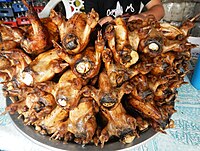Quail as food


Both Old World and New World quail include edible species. The common quail used to be much favoured in French cooking, but quail for the table are now more likely to be domesticated Japanese quail. The common quail is also part of Polish, Maltese, Italian, Mexican, Spanish, and Indian cuisine. Quail are commonly eaten complete with the bones, since these are easily chewed and the small size of the bird makes it inconvenient to remove them.[1] Quails were domesticated in China. China is also the largest producer of quail meat in the world.[2]
Quail that have fed on hemlock (e.g., during migration) may induce acute kidney injury due to accumulation of toxic substances from the hemlock in the meat; this problem is referred to as "coturnism".[3]
A persistent myth holds that it is impossible to eat quail every day for a month. This has been the subject of a number of proposition bets; however, it has been achieved on several occasions.[4]
This "every-day-for-a-month" estimation may have been derived from a Biblical passage about quail. The children of Israel, having become tired of eating manna, demanded flesh to eat. God then gave them quail, but with this warning: "Ye shall not eat one day, nor two days, nor five days, neither ten days, nor twenty days; but even a whole month, until it come out at your nostrils, and it be loathsome unto you: because that ye have despised the Lord which is among you, and have wept before him, saying, Why came we forth out of Egypt?" (Numbers 11:19-20, KJV). Later in the passage, we are told, "And while the flesh was yet between their teeth, ere it was chewed, the wrath of the Lord was kindled against the people, and the Lord smote the people with a very great plague" (Numbers 11:33, KJV).
A 19th-century recipe from California for Codornices a la española (Spanish-style quail) was prepared by stuffing quails with a mixture of mushroom, green onion, parsley, butter, lemon juice and thyme. The birds were brushed with lard, bread crumbs and beaten eggs and finished in the oven. A savory pie could be made with quail, salt pork, eggs and fresh herbs.[5]
Kosher status
Only certain species of quail are considered kosher. The Orthodox Union certifies Coturnix coturnix as kosher based upon the masorah of Rabbi Shlomo Zev Zweigenhaft.[6] [7]
See also
References
- ^ Shanaway, M. M. (1994). Quail Production Systems: A Review. Food & Agriculture Org. ISBN 978-92-5-103384-5.
- ^ Barrow, Paul; Nair, Venugopal; Baigent, Susan; Atterbury, Robert; Clark, Michael (2021-10-08). Poultry Health: A Guide for Professionals. CABI. ISBN 978-1-78924-504-2.
- ^ Tsironi M, Andriopoulos P, Xamodraka E, et al. (2004). "The patient with rhabdomyolysis: have you considered quail poisoning?". CMAJ. 171 (4): 325–6. doi:10.1503/cmaj.1031256. PMC 509041. PMID 15313988.
- ^ "Quail". 27 November 2010.
- ^ El cocinero español by Encarnación Pinedo, 1898
- ^ Staff, OU Kosher (2008-08-22). "The Birds of the Bible, or, Solving the Mystery of Which of the Species are Kosher and Which are Not". OU Kosher Certification. Archived from the original on 2023-12-07. Retrieved 2024-07-01.
- ^ "The Intricacies of Quail - Rabbi Chaim Loike". thejewishheritage.weebly.com. Retrieved 2024-07-01.[permanent dead link]


